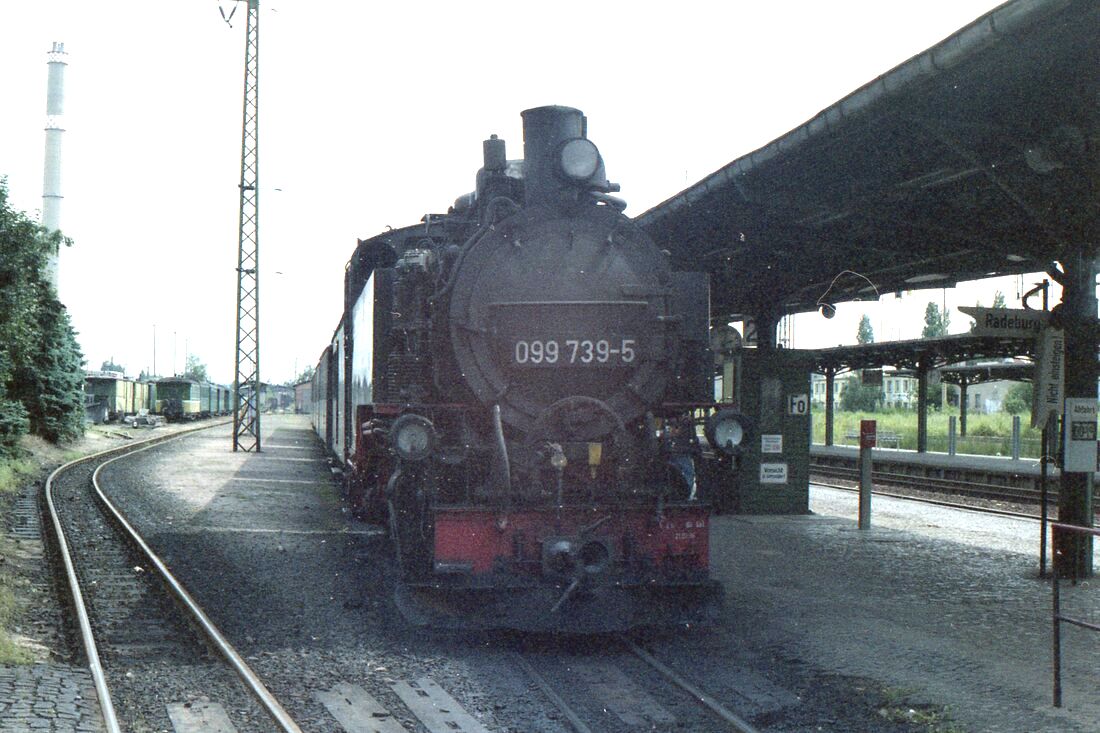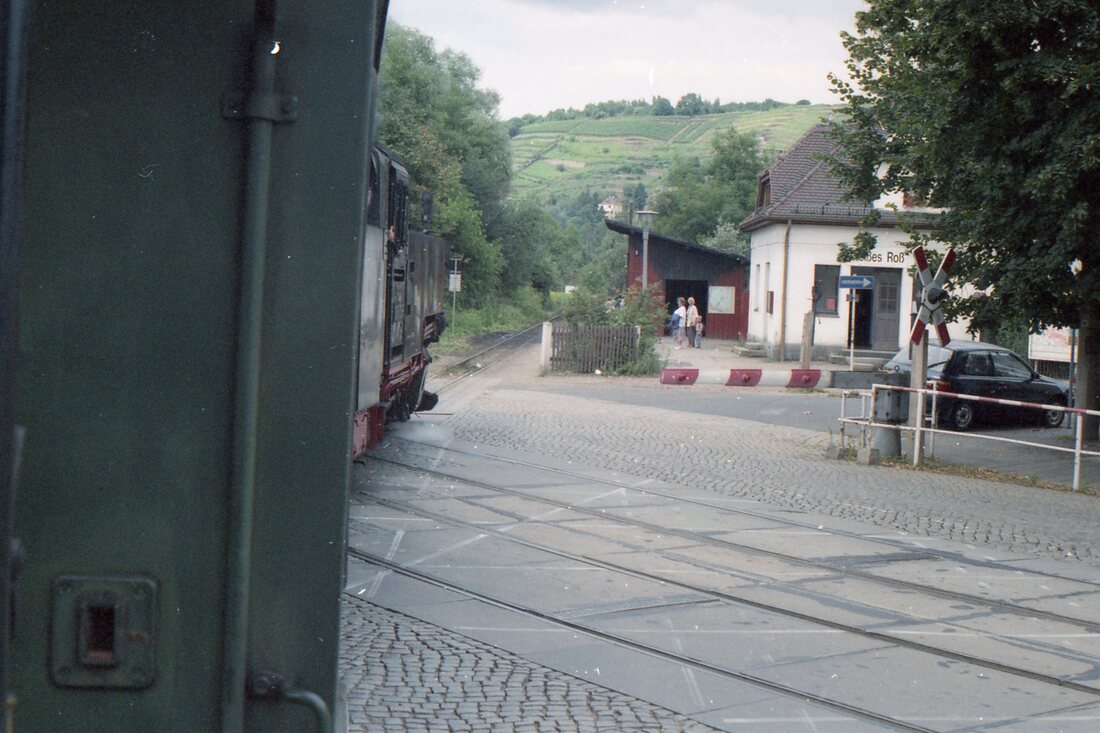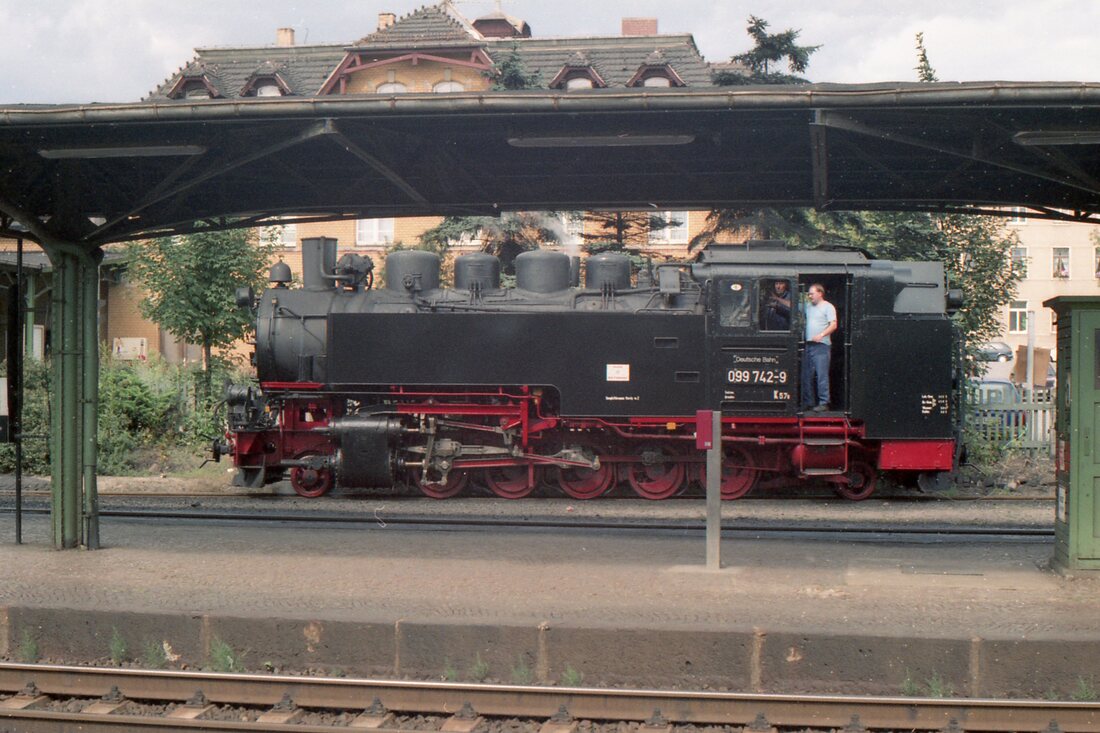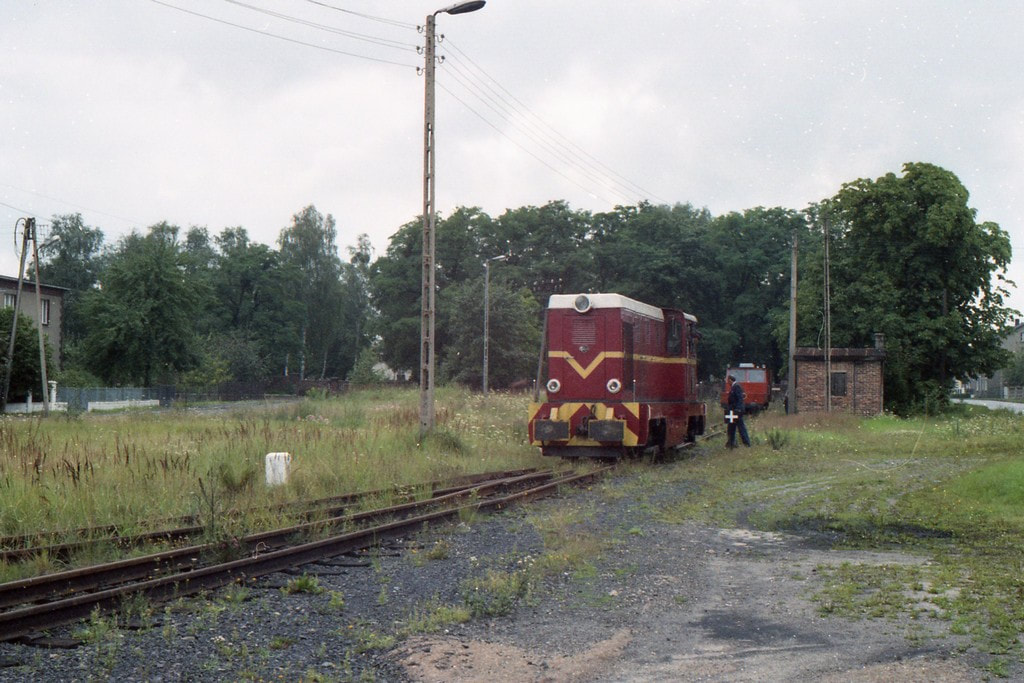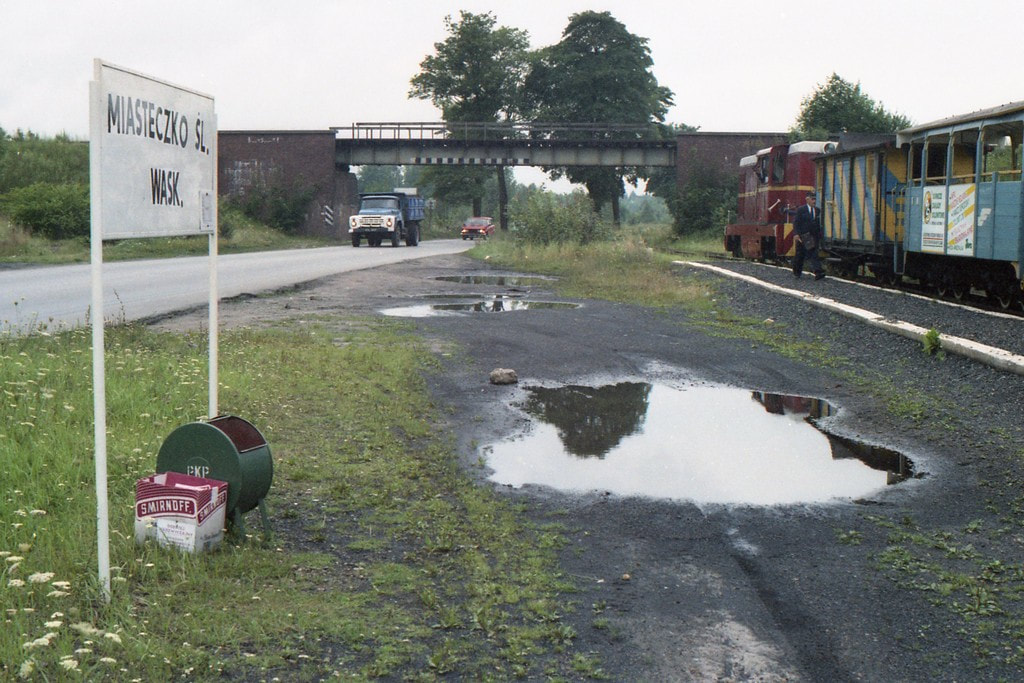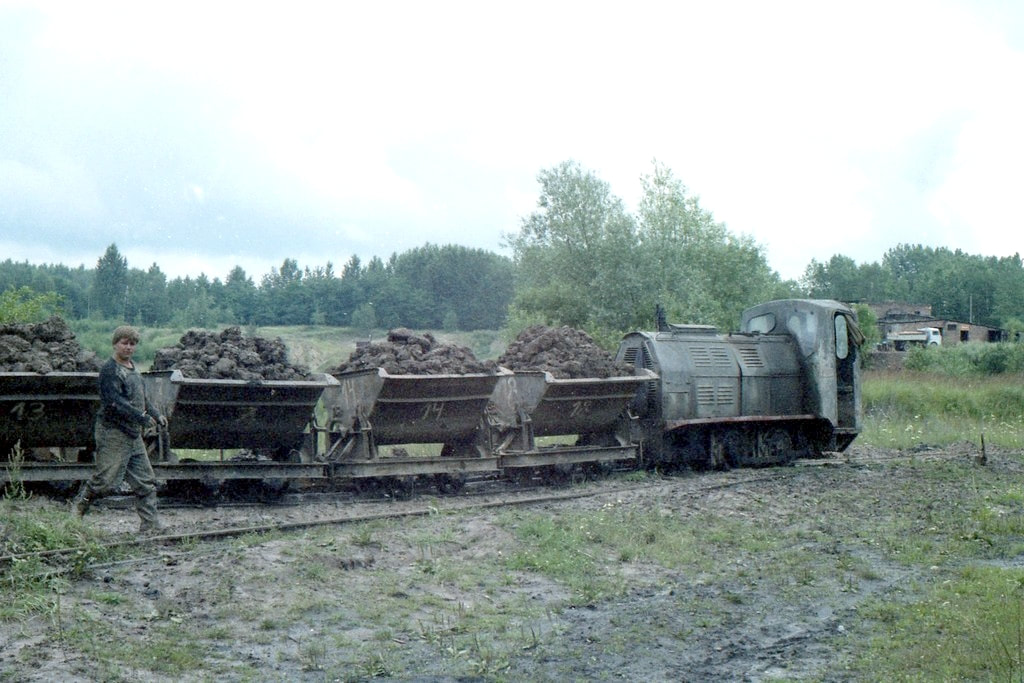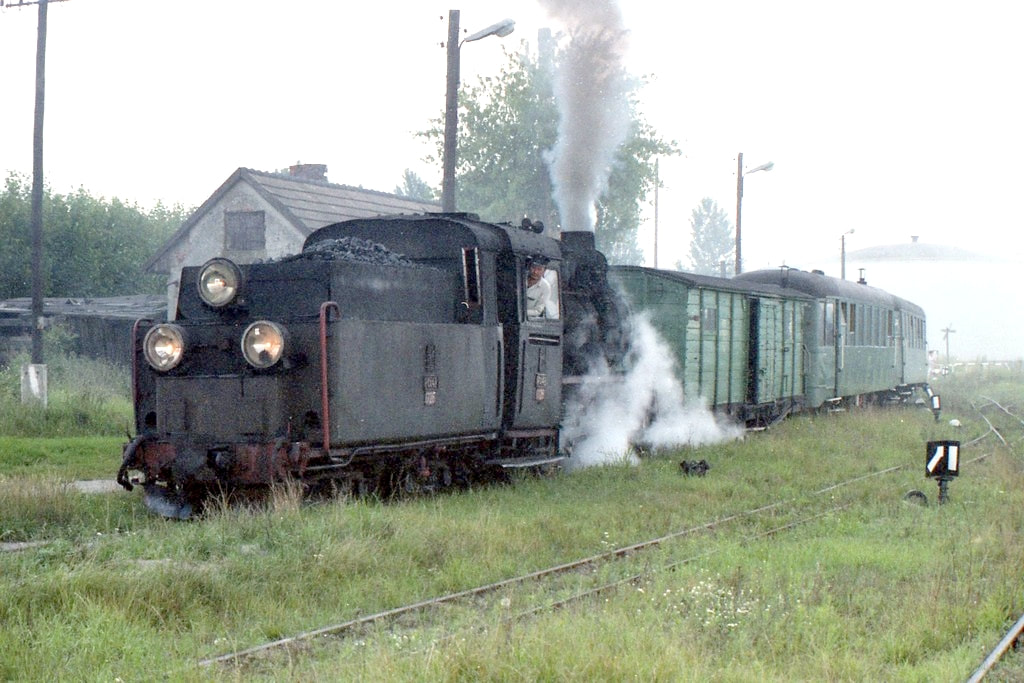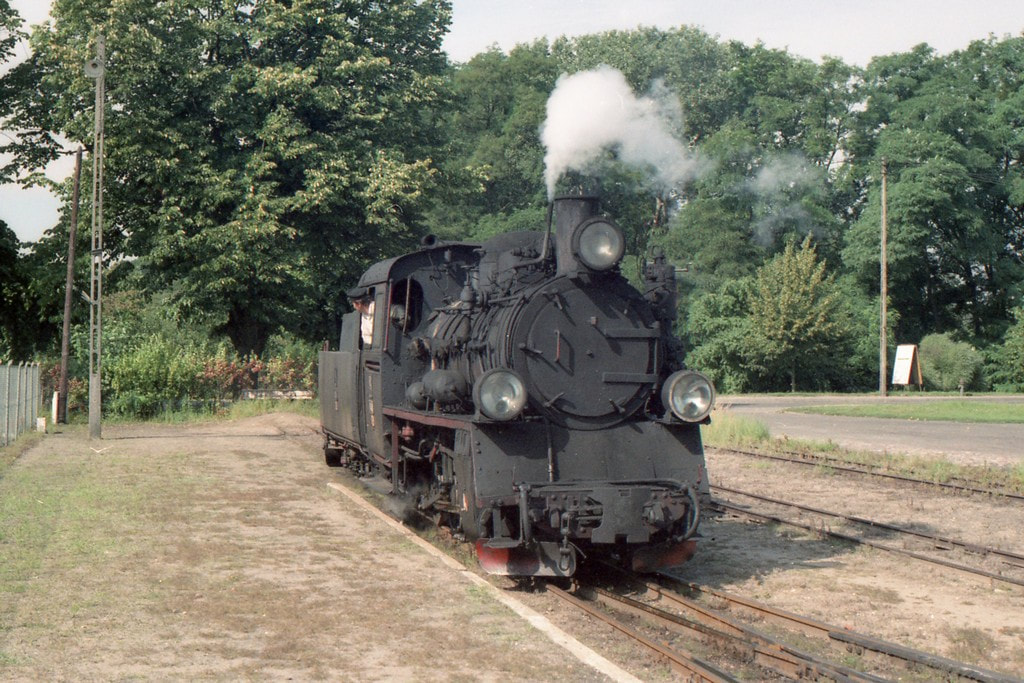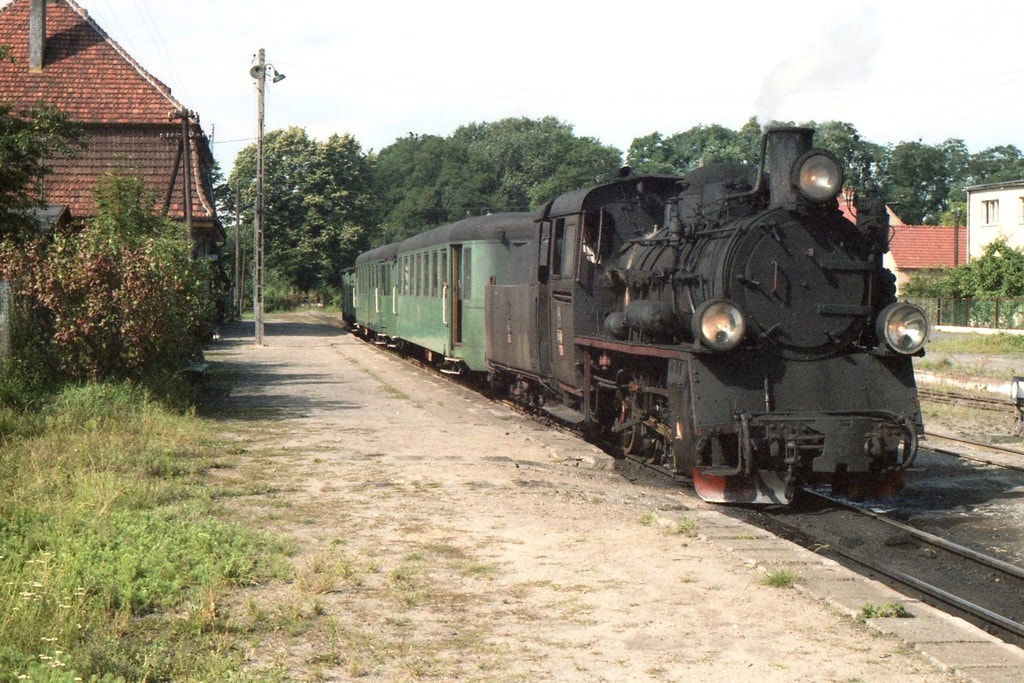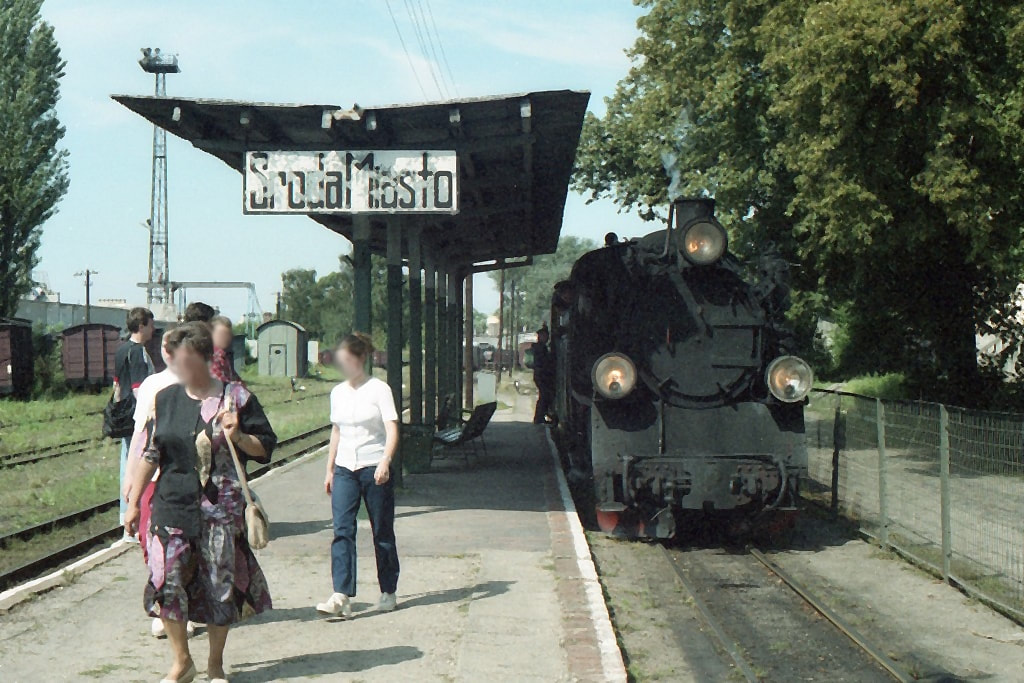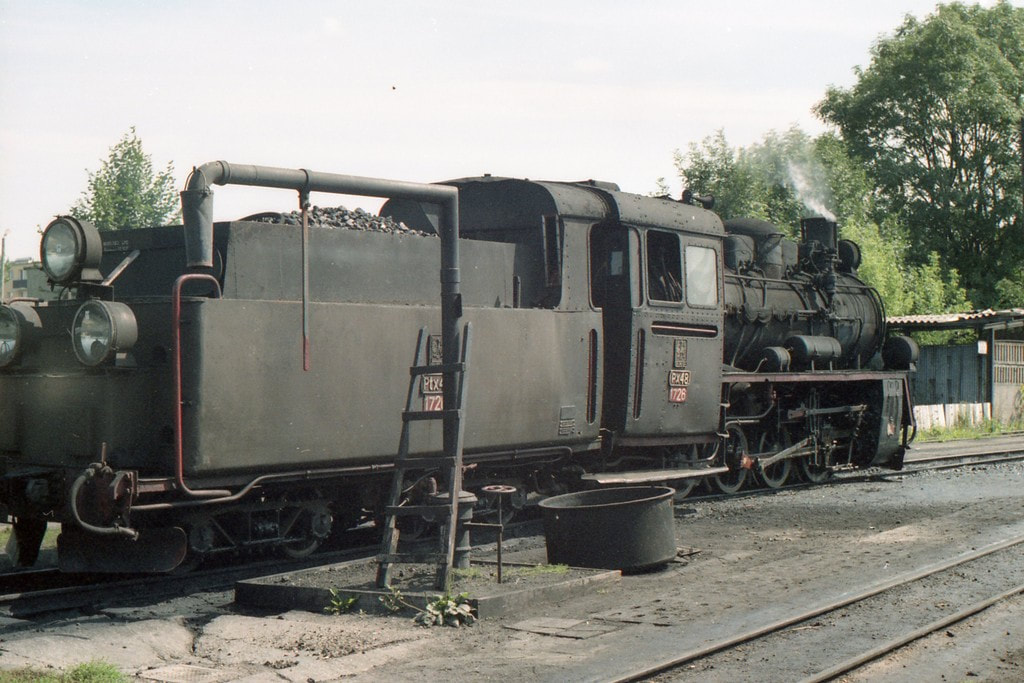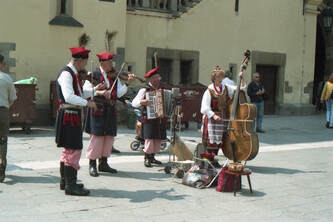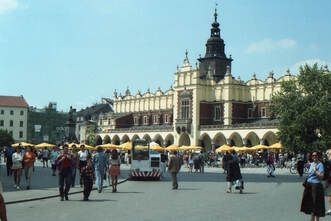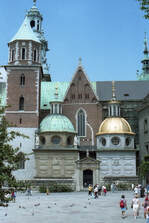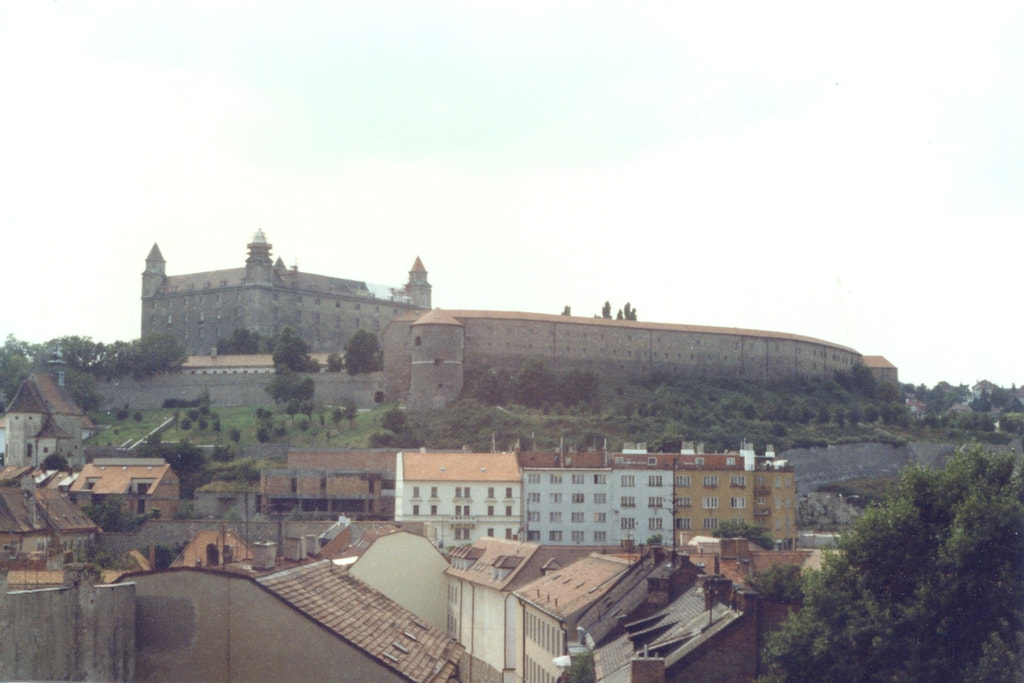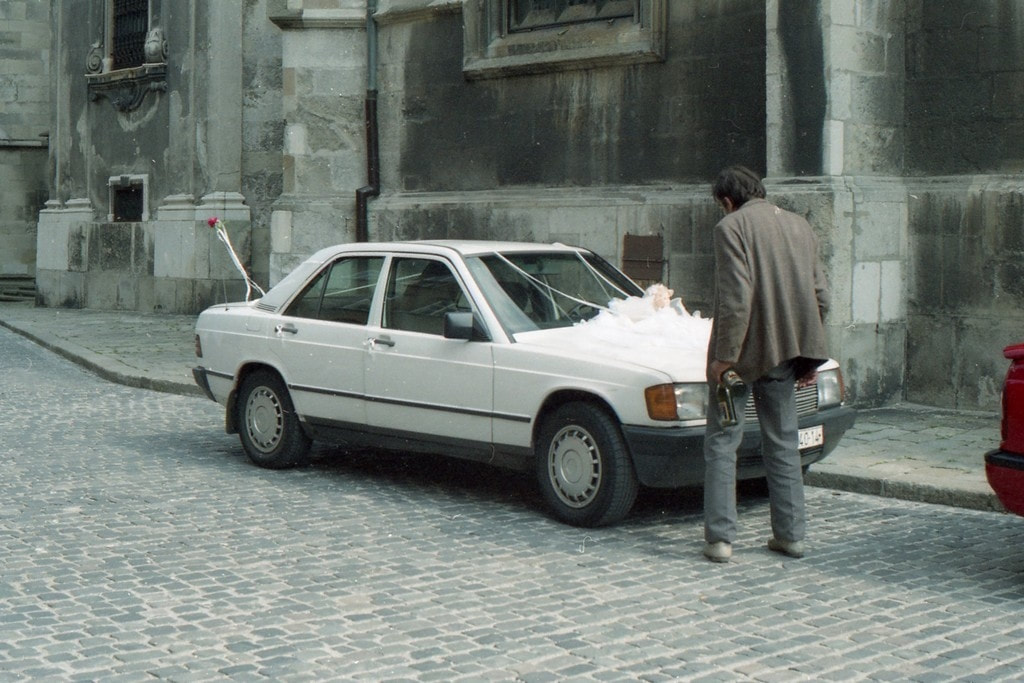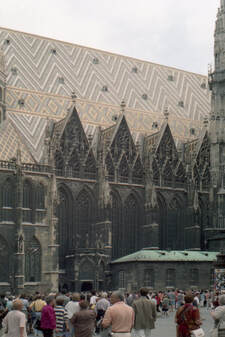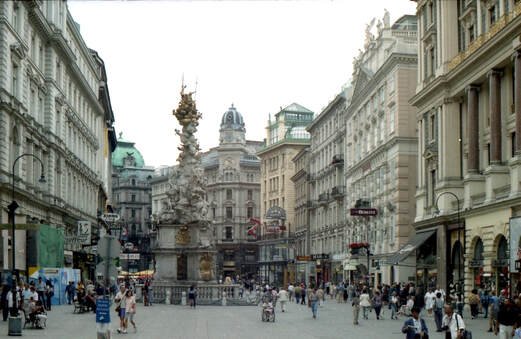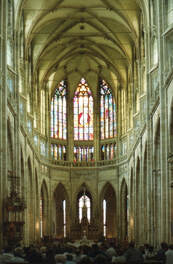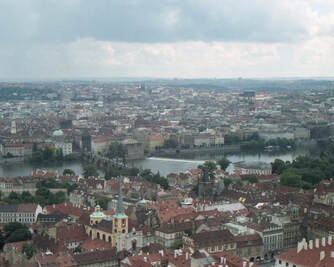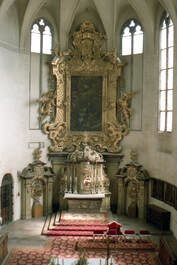Mrs EG and I were married in 1971, and after what seemed like just a few moments, here we were approaching our silver wedding anniversary. Fortuitously, Mrs EG had been invited to attend an academic conference in Krakow just before the date, and we were able to devise a Central Europe tour taking in the conference and visiting several capital cities while we were about it - all shoehorned in between the ADL tour and our actual anniversary date when we wanted to be back in the UK for old times' sake. So after a reunion at 'romantic' (who knew?) Watford Junction we set off for our overnight stay prior to our departure from Heathrow.
Monday 5.8.96
Having stayed (most of) overnight at Odiham, off betimes for Heathrow, leaving the car in the supposedly capable hands of Arthur Daley Car Storage. Checked in early, then the usual fester waiting for the flight (Lufthansa to Köln/Bonn and on to Dresden) at 08:10 which eventually left at 08:30 with the now familiar air traffic control excuses. Uneventful to Köln (good view of cathedral, station etc.) followed by a scary landing with much twitching of aircraft (and passengers). After a short spell in the transit lounge (does this count as gricing the airport? I think so if you get off the aircraft) we were off for the remainder of the flight to Dresden, where as non-scary a landing as can be made, was made. [It can be correctly assumed from this that I dislike all flying and particularly landing even in utterly benign conditions. Until the aircraft turns off the runway it’s sticky-palms time.]
After a brief skirmish with a minibus driver the simple and cheap (DM2 each) way proved to be to get the bus to Karl-Marx-Straße and the tram from there to the stop in front of Dresden Hbf. A quick scamper round for left luggage (DM2 again, far more reasonable than France) and two returns to Radebeul Ost (actually 4 singles at DM2.40) and we were on the 13:35 to Radebeul Ost where – lo and behold – the narrow gauge stock was waiting. Negotiations with The Man in the brake produced a fare of DM8.50 each to Moritzburg and back. Dashed expensive, this steam. The first half of the branch for which I had waited four years [having done only the top half on my 1992 supposed ‘trip of a lifetime’], proved more interesting as it climbs its way out of Radebeul, mostly along roads to Weißes Roß, and then out of (presumably) the Elbe valley to Moritzburg. Here we hurled ourselves into the Radeburg-Radebeul train in order to get back to Dresden with time for a meal, buying tickets, getting Mrs EG’s glasses repaired, getting seat reservations for the following day’s Görlitz - Kraków journey, etc. A very good, plain if rather expensive meal was had at a café almost opposite the Bastei hotel, and belonging to another hotel.
The 17:11 to Görlitz was caught in reasonable comfort. This is really a commuter train, gradually emptying out as it gets further east. It was slightly delayed by connections and engineering, eventually arriving about 8 minutes late. A meeter and greeter was encountered but failed to communicate that there was a tram straight to the Hotel Sorat so, ready for a rest and not a walk, we took a taxi which dropped us at the door for a mere DM10. The Sorat proved to be all that was required and we went out to do the town. Only two pubs within range, both serving a range of wheat beers called Erdinger. The standard (cloudy) one was tried in the first pub – absolutely excellent. The dunkel (dark) in the second was only slightly inferior. Mrs EG had a major debate to get an untoasted ham sandwich but got her way eventually! [I’m still fond of Erdinger Weissbrau, if only for old times’ sake – it is of course a mass market beer from an independent brewery near München, so much so that it’s available in my local Tesco along with its rival, München’s Franziskaner (Anheuser-Busch InBev)– but this review reflects my complete ignorance in 1996 of anything but a few fairly grim pilsners from former DDR breweries!]
Having stayed (most of) overnight at Odiham, off betimes for Heathrow, leaving the car in the supposedly capable hands of Arthur Daley Car Storage. Checked in early, then the usual fester waiting for the flight (Lufthansa to Köln/Bonn and on to Dresden) at 08:10 which eventually left at 08:30 with the now familiar air traffic control excuses. Uneventful to Köln (good view of cathedral, station etc.) followed by a scary landing with much twitching of aircraft (and passengers). After a short spell in the transit lounge (does this count as gricing the airport? I think so if you get off the aircraft) we were off for the remainder of the flight to Dresden, where as non-scary a landing as can be made, was made. [It can be correctly assumed from this that I dislike all flying and particularly landing even in utterly benign conditions. Until the aircraft turns off the runway it’s sticky-palms time.]
After a brief skirmish with a minibus driver the simple and cheap (DM2 each) way proved to be to get the bus to Karl-Marx-Straße and the tram from there to the stop in front of Dresden Hbf. A quick scamper round for left luggage (DM2 again, far more reasonable than France) and two returns to Radebeul Ost (actually 4 singles at DM2.40) and we were on the 13:35 to Radebeul Ost where – lo and behold – the narrow gauge stock was waiting. Negotiations with The Man in the brake produced a fare of DM8.50 each to Moritzburg and back. Dashed expensive, this steam. The first half of the branch for which I had waited four years [having done only the top half on my 1992 supposed ‘trip of a lifetime’], proved more interesting as it climbs its way out of Radebeul, mostly along roads to Weißes Roß, and then out of (presumably) the Elbe valley to Moritzburg. Here we hurled ourselves into the Radeburg-Radebeul train in order to get back to Dresden with time for a meal, buying tickets, getting Mrs EG’s glasses repaired, getting seat reservations for the following day’s Görlitz - Kraków journey, etc. A very good, plain if rather expensive meal was had at a café almost opposite the Bastei hotel, and belonging to another hotel.
The 17:11 to Görlitz was caught in reasonable comfort. This is really a commuter train, gradually emptying out as it gets further east. It was slightly delayed by connections and engineering, eventually arriving about 8 minutes late. A meeter and greeter was encountered but failed to communicate that there was a tram straight to the Hotel Sorat so, ready for a rest and not a walk, we took a taxi which dropped us at the door for a mere DM10. The Sorat proved to be all that was required and we went out to do the town. Only two pubs within range, both serving a range of wheat beers called Erdinger. The standard (cloudy) one was tried in the first pub – absolutely excellent. The dunkel (dark) in the second was only slightly inferior. Mrs EG had a major debate to get an untoasted ham sandwich but got her way eventually! [I’m still fond of Erdinger Weissbrau, if only for old times’ sake – it is of course a mass market beer from an independent brewery near München, so much so that it’s available in my local Tesco along with its rival, München’s Franziskaner (Anheuser-Busch InBev)– but this review reflects my complete ignorance in 1996 of anything but a few fairly grim pilsners from former DDR breweries!]
Tuesday 6.8.96
Peace reigned until the alarm went at 6 for an 07:00 breakfast. Breakfast was to the usual excellent German standard but despite this we managed to get away just after 07:30 for the no. 1 tram. With my customary attention to detail I defeated the ticket machine but got us on a tram going in the opposite direction; fortunately having realised fairly quickly we were able to get out at the next stop where standing in front of the departing tram going the other way and waving my arms at the driver persuaded him to reconsider. A safe arrival therefore at Görlitz station where the supermarket was patronised for on-train refreshments.
Following the signs to platform 11 we found ourselves on platform 12 which had a Dresden train indicated and a large fence between it and 11. Assuming we had just taken the wrong subway we walked round the end of the fence, still on the platform, and started down the train only to be rounded up by German and Polish immigration people and deposited back on the other side of the fence with an explanatory ‘English’ to the admiring crowd. A few minutes later we were inspected properly and soon ensconced in a PKP ‘declassified first’ in what we fondly imagined to be our reserved seats. They weren’t, but were more comfortable so we stayed put. [In retrospect the unintended evasion of border formalities seems rather stupid, to say the least, but in fairness I’d never entered Poland from a border station before and after several years of swanning about in the Low Countries where border formalities were minimal or non-existent, or in Germany where I arrived by air, it hadn’t occurred to me that the German-Polish land arrangements might still be a bit more formal. Post-Schengen and with Poland in the EU, of course, it’s a different story.]
There followed a long haul via Wegliniec and Legnice to Wrocław, where the Kraków and Warszawa portions were split and each attached to another train. In our case we inherited a buffet car where I subsequently discovered that Polish ham sandwiches could include pickled cucumber and tomato sauce, and that the buffet car can sell reasonable beer. [A hint of ‘any port in a storm’ here perhaps, as the beer in question was Żywiec, a mass market product from the Heineken stable now sold in our local ‘convenience store’. To be fair it does seem to be Rheinheitsgebot spec as well as being 5.6% ABV]. As I had no złotys a deal was struck in DM (DM8, about £3.80 for two freshly made sandwiches and almost 2 pints of beer). It was then found that I had only DM6.60 or a DM20 note, so the DM6.60 (£3) was settled on. I don’t think WARS lost out. I took the empty bottles back as a gesture of appreciation (someone tried to scrounge them at Katowice so presumably they’re worth a grosz or two).
Wrocław to Katowice is another long trudge via Opole and then (slightly to my surprise) Kędzierzyn-Koźle, Gliwice and Ruda Chebzie. [I don’t recall why I was surprised by taking the standard route!] At Katowice we were about 8 late and lost another 10 on the stretch to Kraków via Sosnowiec Jęzor, Jaworzno Szczakowa, and Trzebinia. After the long stretch of run down industry either side of Katowice the last half an hour or so into Kraków is relatively scenic (but only relatively).
Mrs HG was safely delivered to her conference via a taxi which confirmed the opinion of Polish taxi drivers formed in Poznań last year, and I took a breather while she attended the last lecture of the day. When she returned there was much animated discussion among the British contingent about the bathroom suites in the Hotel Krakowiak (brown toilet, turquoise seat, multicoloured shower curtains etc.). On arrival it proved to be very similar to a couple of establishments encountered in Rostock and Alexisbad in 1992. After a conference dinner (pea? soup, steak? on bread with fried potato balls, chocolate gateau) most went to a concert; we retired to Rynek Główny (main square) in Stare Miasto (old town), which is exceptional by anyone’s standards. It also contains a number of pavement cafés, one of which we patronised for some Okocim beer. [Since 1996 a Carlsberg offshoot]. In this ultra-tourist ripoff area 500 ml (nearly 0.9pt) cost Zł4 (£1). I suspect Wien may be different... [It was.] Back to the hotel by tram and foot, keeping up the record of a tram in every town so far.
Peace reigned until the alarm went at 6 for an 07:00 breakfast. Breakfast was to the usual excellent German standard but despite this we managed to get away just after 07:30 for the no. 1 tram. With my customary attention to detail I defeated the ticket machine but got us on a tram going in the opposite direction; fortunately having realised fairly quickly we were able to get out at the next stop where standing in front of the departing tram going the other way and waving my arms at the driver persuaded him to reconsider. A safe arrival therefore at Görlitz station where the supermarket was patronised for on-train refreshments.
Following the signs to platform 11 we found ourselves on platform 12 which had a Dresden train indicated and a large fence between it and 11. Assuming we had just taken the wrong subway we walked round the end of the fence, still on the platform, and started down the train only to be rounded up by German and Polish immigration people and deposited back on the other side of the fence with an explanatory ‘English’ to the admiring crowd. A few minutes later we were inspected properly and soon ensconced in a PKP ‘declassified first’ in what we fondly imagined to be our reserved seats. They weren’t, but were more comfortable so we stayed put. [In retrospect the unintended evasion of border formalities seems rather stupid, to say the least, but in fairness I’d never entered Poland from a border station before and after several years of swanning about in the Low Countries where border formalities were minimal or non-existent, or in Germany where I arrived by air, it hadn’t occurred to me that the German-Polish land arrangements might still be a bit more formal. Post-Schengen and with Poland in the EU, of course, it’s a different story.]
There followed a long haul via Wegliniec and Legnice to Wrocław, where the Kraków and Warszawa portions were split and each attached to another train. In our case we inherited a buffet car where I subsequently discovered that Polish ham sandwiches could include pickled cucumber and tomato sauce, and that the buffet car can sell reasonable beer. [A hint of ‘any port in a storm’ here perhaps, as the beer in question was Żywiec, a mass market product from the Heineken stable now sold in our local ‘convenience store’. To be fair it does seem to be Rheinheitsgebot spec as well as being 5.6% ABV]. As I had no złotys a deal was struck in DM (DM8, about £3.80 for two freshly made sandwiches and almost 2 pints of beer). It was then found that I had only DM6.60 or a DM20 note, so the DM6.60 (£3) was settled on. I don’t think WARS lost out. I took the empty bottles back as a gesture of appreciation (someone tried to scrounge them at Katowice so presumably they’re worth a grosz or two).
Wrocław to Katowice is another long trudge via Opole and then (slightly to my surprise) Kędzierzyn-Koźle, Gliwice and Ruda Chebzie. [I don’t recall why I was surprised by taking the standard route!] At Katowice we were about 8 late and lost another 10 on the stretch to Kraków via Sosnowiec Jęzor, Jaworzno Szczakowa, and Trzebinia. After the long stretch of run down industry either side of Katowice the last half an hour or so into Kraków is relatively scenic (but only relatively).
Mrs HG was safely delivered to her conference via a taxi which confirmed the opinion of Polish taxi drivers formed in Poznań last year, and I took a breather while she attended the last lecture of the day. When she returned there was much animated discussion among the British contingent about the bathroom suites in the Hotel Krakowiak (brown toilet, turquoise seat, multicoloured shower curtains etc.). On arrival it proved to be very similar to a couple of establishments encountered in Rostock and Alexisbad in 1992. After a conference dinner (pea? soup, steak? on bread with fried potato balls, chocolate gateau) most went to a concert; we retired to Rynek Główny (main square) in Stare Miasto (old town), which is exceptional by anyone’s standards. It also contains a number of pavement cafés, one of which we patronised for some Okocim beer. [Since 1996 a Carlsberg offshoot]. In this ultra-tourist ripoff area 500 ml (nearly 0.9pt) cost Zł4 (£1). I suspect Wien may be different... [It was.] Back to the hotel by tram and foot, keeping up the record of a tram in every town so far.
Wednesday 7.8.96
Up at 03:30 in time to ask the concierge to order a taxi just after 04:00. This turned up promptly and delivered me quickly, if dangerously, to the station in good time for 04:40 to Katowice, This was an EN57 EMU with hard seats and the heating on full blast. Mercifully the guard turned it off after a while. No first class, and being a parliamentary, very slow. A quick change at the very drab station at Katowice, then on ‘main line’ stock as far as Bytom on the 06:24 to Poznań. This proved to be the only first class accommodation of the day. At Bytom the narrow gauge was discovered with the help of directions from a UK acquaintance (and a bit of luck) and a small poster seemed to confirm the timings given in OEIS. Attempts to find out about tickets back at the main station had foundered linguistically so as it appeared still to be a PKP line I decided to try the Euro Domino. An excursion was made to the town (dreary) and a travellers’ cheque [remember them?] cashed at the bank just after 08:00. Better rate than the hotel (2nd) or Kantor (3rd) in Kraków, but it took so long that there was insufficient time to buy breakfast supplies. At least water had been obtained at the station.
The narrow gauge turned out to have gaudily painted open sided coaches, diesel hauled contrary to rumour, which were a bit cold for a grey, damp morning at 08:30. The Euro Domino was deemed valid and we trundled off (‘we’ being me, the train crew, two diesels and the train – no other passengers) northwards. The n.g. runs in quite close proximity to the main line for some way, eventually crossing to the east side. There were a lot of coal wagons around, particularly at the depot (couldn’t see the steam loco, presumably in the shed) north of Bytom but it wasn’t possible to reach a definite conclusion whether any freight still runs. Some of the line runs through woods and must be a very pleasant ride on a sunny (and therefore warmer!) day. It’s pretty interesting, anyway. At Tarnowskie Góry it runs very close to the main line station but inexplicably doesn’t stop. After the rather less scenic last stretch to Miasteczko Śląskie the line terminates in a small fenced off coal (?) yard (which contains a Polish-equivalent Wickham trolley) with the platform and loop just before it. The loco was removed and run round with the usual east European efficiency. The station is on the northern edge of town so nothing for it but to walk in and get directions to the main line station (past the post office, first left, keep walking – and I mean keep walking.) Just before the main station there is a narrow gauge industrial line, purpose unknown, where a small diesel was working with some tipper wagons. The loco crew seemed amused that I bothered to photograph it. There must be a depot nearby on the main line as an endless stream of light engines arrived, reversed at the south end of the platforms and disappeared again southwards. [In fact there’s a very large marshalling yard a few hundred metres to the south].
The EMU (EN57, soft seats) for Kalety arrived eventually and I took it, disembarking at Kalety. A female station staff person was directing passengers across the line through a gate – I asked her if I should stay on the same platform for Poznań and she indicated that I should. Wrong. I decided to hedge my bets and stand on the footbridge, to see an approaching EN57 cross over to the other platform. It said ‘Kepno’ on the front, but given the scarcity of trains, seemed the best option. A frantic thumb through the timetable suggested that Kepno was the right horse to back, so I did. It was. I hadn’t noticed the change of train numbers in the timetable, the only clue that the train didn’t go through to Poznań. All well, however, and an extremely tedious all stations journey to Środa was enlivened by changing at Kepno and seeing the narrow gauge connecting train at Pleszew.
Arriving at Środa I went in search of the narrow gauge, only to find that I had completely misunderstood the timetable and couldn’t get to Zaniemyśl and back by a suitable time (and still no accommodation booked in Poznań!). I therefore recast my plans to reduce the main line steam part, omit the Pleszew narrow gauge, and do Zaniemyśl the following day, contenting myself with a few photos of PX48-1726 running tender first on the 16:39 to Zaniemyśl. [With the wisdom of hindsight, the change of plan was a serious mistake!] I also noticed that the n.g. tracks in the exchange sidings had been used recently but couldn’t figure out why. Two transporter wagons were present, so maybe loco coal. I was able to get the 17:54 to Poznań, thus arriving at a civilised hour, and get a room at the Hotel Merkury (very comfortable though not particularly cheap at £35). It’s just at the top of the drive from the station, about 15 minutes walk from the bay platforms. [I suspect it’s the Mercure now, bargain rate £166 with breakfast!]. The Old Town is nowhere near the equal of Kraków. None of the bars seemed to be serving meals so short of the ‘dodgy hot dog’ brigade, the only option was McDonald’s. Ah well.
Up at 03:30 in time to ask the concierge to order a taxi just after 04:00. This turned up promptly and delivered me quickly, if dangerously, to the station in good time for 04:40 to Katowice, This was an EN57 EMU with hard seats and the heating on full blast. Mercifully the guard turned it off after a while. No first class, and being a parliamentary, very slow. A quick change at the very drab station at Katowice, then on ‘main line’ stock as far as Bytom on the 06:24 to Poznań. This proved to be the only first class accommodation of the day. At Bytom the narrow gauge was discovered with the help of directions from a UK acquaintance (and a bit of luck) and a small poster seemed to confirm the timings given in OEIS. Attempts to find out about tickets back at the main station had foundered linguistically so as it appeared still to be a PKP line I decided to try the Euro Domino. An excursion was made to the town (dreary) and a travellers’ cheque [remember them?] cashed at the bank just after 08:00. Better rate than the hotel (2nd) or Kantor (3rd) in Kraków, but it took so long that there was insufficient time to buy breakfast supplies. At least water had been obtained at the station.
The narrow gauge turned out to have gaudily painted open sided coaches, diesel hauled contrary to rumour, which were a bit cold for a grey, damp morning at 08:30. The Euro Domino was deemed valid and we trundled off (‘we’ being me, the train crew, two diesels and the train – no other passengers) northwards. The n.g. runs in quite close proximity to the main line for some way, eventually crossing to the east side. There were a lot of coal wagons around, particularly at the depot (couldn’t see the steam loco, presumably in the shed) north of Bytom but it wasn’t possible to reach a definite conclusion whether any freight still runs. Some of the line runs through woods and must be a very pleasant ride on a sunny (and therefore warmer!) day. It’s pretty interesting, anyway. At Tarnowskie Góry it runs very close to the main line station but inexplicably doesn’t stop. After the rather less scenic last stretch to Miasteczko Śląskie the line terminates in a small fenced off coal (?) yard (which contains a Polish-equivalent Wickham trolley) with the platform and loop just before it. The loco was removed and run round with the usual east European efficiency. The station is on the northern edge of town so nothing for it but to walk in and get directions to the main line station (past the post office, first left, keep walking – and I mean keep walking.) Just before the main station there is a narrow gauge industrial line, purpose unknown, where a small diesel was working with some tipper wagons. The loco crew seemed amused that I bothered to photograph it. There must be a depot nearby on the main line as an endless stream of light engines arrived, reversed at the south end of the platforms and disappeared again southwards. [In fact there’s a very large marshalling yard a few hundred metres to the south].
The EMU (EN57, soft seats) for Kalety arrived eventually and I took it, disembarking at Kalety. A female station staff person was directing passengers across the line through a gate – I asked her if I should stay on the same platform for Poznań and she indicated that I should. Wrong. I decided to hedge my bets and stand on the footbridge, to see an approaching EN57 cross over to the other platform. It said ‘Kepno’ on the front, but given the scarcity of trains, seemed the best option. A frantic thumb through the timetable suggested that Kepno was the right horse to back, so I did. It was. I hadn’t noticed the change of train numbers in the timetable, the only clue that the train didn’t go through to Poznań. All well, however, and an extremely tedious all stations journey to Środa was enlivened by changing at Kepno and seeing the narrow gauge connecting train at Pleszew.
Arriving at Środa I went in search of the narrow gauge, only to find that I had completely misunderstood the timetable and couldn’t get to Zaniemyśl and back by a suitable time (and still no accommodation booked in Poznań!). I therefore recast my plans to reduce the main line steam part, omit the Pleszew narrow gauge, and do Zaniemyśl the following day, contenting myself with a few photos of PX48-1726 running tender first on the 16:39 to Zaniemyśl. [With the wisdom of hindsight, the change of plan was a serious mistake!] I also noticed that the n.g. tracks in the exchange sidings had been used recently but couldn’t figure out why. Two transporter wagons were present, so maybe loco coal. I was able to get the 17:54 to Poznań, thus arriving at a civilised hour, and get a room at the Hotel Merkury (very comfortable though not particularly cheap at £35). It’s just at the top of the drive from the station, about 15 minutes walk from the bay platforms. [I suspect it’s the Mercure now, bargain rate £166 with breakfast!]. The Old Town is nowhere near the equal of Kraków. None of the bars seemed to be serving meals so short of the ‘dodgy hot dog’ brigade, the only option was McDonald’s. Ah well.
Thursday 8.8.96
Going to bed at 20:45 makes 05:00 quite reasonable! There was enough time to shave, shower and get to the station for the 05:50 to Wolsztyn which I left at Trzebaw Rosnówko (not a crossing point) rather than risk missing a cross platform change later on. Sadly the incoming service to Poznań, although showing as steam worked in the timetable and in all known publications recently, was diesel hauled. Ah well, again.
Back to Poznań to have my spirits restored by a very good German type breakfast although with orange squash instead of orange juice. Checkout beforehand had been extremely quick despite the hordes of coach travellers who had arrived the previous night. Presumably they had the day in Poznań. Arriving at the station at 08:00 I had to get reservations for the following day’s Kraków-Bratislava trip but the booking clerk seemed to be having great difficuly. I had to abandon the attempt in order to catch the 08:20 to Środa. Should have known better – having taken the same route through the timetable that the booking clerk did, it seems that only a few trains in Poland are reservable, and that isn’t one. At Środa there was only a ten minute connection for the narrow gauge but the main line train was on time, so no problem. A reasonable crowd of locals boarded the train (no other gricers, photters etc.) which proceeded sedately to Zaniemyśl stopping to set down or pick up various people, mostly shoppers. For about two miles before Zaniemyśl a road runs beside the line for quite long stretches and might be good for chasing – sun on the right side, telegraph poles on the opposite side, no hedge, etc. One problem is that coming back the loco would be chimney first but you would have oncoming traffic ‘twixt camera and train.
I had Zaniemyśl more or less to myself though the sun was on the wrong (platform) side. Worthwhile, though. One gricer/spotter (Polish) appeared, otherwise all locals again on the way back, which was very pleasant. All distractions vanished at Środa Miasto and I had the shed to myself, complete with two locos (forgot to look for the scrap one at the side). I left with great regret for the 15 minute plod down to the main line station and a 1¼ hour wait for the 13:05 to Kepno.
EN57 again, packed to the doors, but I did get a seat. I was slightly confused on arrival at Kepno which appeared only to have room for two trains, as there were two trains booked to depart at 15:35 and 15:37. On closer examination, Kepno has a Tamworth type layout with an east-west line overhead carrying the rambling line 181. The direct train to Katowice was a cross platform connection and I opted for this because although it gave me lsess track it did give me the stretch between Miasteczko Śląskie and Bytom. EN57 again of course, proceeding slowly but punctually via all stations with a few glimpses of the narrow gauge. Interestingly there is a well used double track narrow gauge line which passes under the main line south of Bytom. [Like the line I travelled on the previous day from Bytom, this would have been part of the Górnośląskie Koleje Wąskotorowe (Upper Silesian Narrow Gauge Railways) network, which was gradually being closed down through the 1990s.
Arriving at Katowice I had time for a quick walk outside the station as far as McDonald’s – the first I recall to have a bouncer albeit he didn’t look too effective. [There followed a rather harsh criticism of Katowice which I’ve left out. In fairness, I’ve been back several times, the last in 2019, and the station and its surroundings have changed beyond all recognition and for the better. I’ve seen more of the city too, and the improvement’s not just localised.] Back to Kraków on an InterCity of sorts, thus getting a rare sample of first class travel with arrival pretty well on time at 21:21. I got back to the Hotel Krakowiak at 22:15 by tram/walk after after an abortive sortie from the station which went so far in the wrong direction that I had to get a tram back to the station to start again! All well, however, and the evening ended with a vodka-assisted singsong among a multinational (English/German/Finnish/Russian) intellectual elite. [No sarcasm here – my B.Sc (Eng) was by some measure the lowest grade of academic achievement present!].
Going to bed at 20:45 makes 05:00 quite reasonable! There was enough time to shave, shower and get to the station for the 05:50 to Wolsztyn which I left at Trzebaw Rosnówko (not a crossing point) rather than risk missing a cross platform change later on. Sadly the incoming service to Poznań, although showing as steam worked in the timetable and in all known publications recently, was diesel hauled. Ah well, again.
Back to Poznań to have my spirits restored by a very good German type breakfast although with orange squash instead of orange juice. Checkout beforehand had been extremely quick despite the hordes of coach travellers who had arrived the previous night. Presumably they had the day in Poznań. Arriving at the station at 08:00 I had to get reservations for the following day’s Kraków-Bratislava trip but the booking clerk seemed to be having great difficuly. I had to abandon the attempt in order to catch the 08:20 to Środa. Should have known better – having taken the same route through the timetable that the booking clerk did, it seems that only a few trains in Poland are reservable, and that isn’t one. At Środa there was only a ten minute connection for the narrow gauge but the main line train was on time, so no problem. A reasonable crowd of locals boarded the train (no other gricers, photters etc.) which proceeded sedately to Zaniemyśl stopping to set down or pick up various people, mostly shoppers. For about two miles before Zaniemyśl a road runs beside the line for quite long stretches and might be good for chasing – sun on the right side, telegraph poles on the opposite side, no hedge, etc. One problem is that coming back the loco would be chimney first but you would have oncoming traffic ‘twixt camera and train.
I had Zaniemyśl more or less to myself though the sun was on the wrong (platform) side. Worthwhile, though. One gricer/spotter (Polish) appeared, otherwise all locals again on the way back, which was very pleasant. All distractions vanished at Środa Miasto and I had the shed to myself, complete with two locos (forgot to look for the scrap one at the side). I left with great regret for the 15 minute plod down to the main line station and a 1¼ hour wait for the 13:05 to Kepno.
EN57 again, packed to the doors, but I did get a seat. I was slightly confused on arrival at Kepno which appeared only to have room for two trains, as there were two trains booked to depart at 15:35 and 15:37. On closer examination, Kepno has a Tamworth type layout with an east-west line overhead carrying the rambling line 181. The direct train to Katowice was a cross platform connection and I opted for this because although it gave me lsess track it did give me the stretch between Miasteczko Śląskie and Bytom. EN57 again of course, proceeding slowly but punctually via all stations with a few glimpses of the narrow gauge. Interestingly there is a well used double track narrow gauge line which passes under the main line south of Bytom. [Like the line I travelled on the previous day from Bytom, this would have been part of the Górnośląskie Koleje Wąskotorowe (Upper Silesian Narrow Gauge Railways) network, which was gradually being closed down through the 1990s.
Arriving at Katowice I had time for a quick walk outside the station as far as McDonald’s – the first I recall to have a bouncer albeit he didn’t look too effective. [There followed a rather harsh criticism of Katowice which I’ve left out. In fairness, I’ve been back several times, the last in 2019, and the station and its surroundings have changed beyond all recognition and for the better. I’ve seen more of the city too, and the improvement’s not just localised.] Back to Kraków on an InterCity of sorts, thus getting a rare sample of first class travel with arrival pretty well on time at 21:21. I got back to the Hotel Krakowiak at 22:15 by tram/walk after after an abortive sortie from the station which went so far in the wrong direction that I had to get a tram back to the station to start again! All well, however, and the evening ended with a vodka-assisted singsong among a multinational (English/German/Finnish/Russian) intellectual elite. [No sarcasm here – my B.Sc (Eng) was by some measure the lowest grade of academic achievement present!].
Friday 9.8.96
Mrs EG having decided to miss the final morning of the conference, it was breakfast at 8 prior to some sightseeing. Luggage was left at the station and we departed to look at the cathedral and have a wander through the stalls under the Cloth Hall and around Rynek Główny. After a minor medical issue on my part we were able to see Leonardo’s ‘Lady with an Ermine’ which came as a bit of a surprise!
Back at the station luggage was retrieved and Polish money exchanged before departing on the 14:25 to Bratislava – surprisingly only 1 first and 3 second class coaches, all ZSR stock only marginally more salubrious than PKP. The route was back towards Katowice as far as Trzebinia then south through Oświęcim (German name Auschwitz) where, probably fortunately, you can’t see the camp from the main line. After reversal at Czechowice-Dziedzice there is a very, very, very slow single line drag down to the border at Zwardon where the Polish and Slovak immigration and customs people had enormous fun stamping passports, checking the usual hand written lists, asking about alcohol, tobacco and drugs, etc. [All a thing of the past with both countries in the EU and Schengen in place]. There was another delay at Skalice (the Slovak border town) while we crossed an international train going north, then we set off far more briskly for Žilina where, surprisingly, we arrived right time.
The ZSR diesel was exchanged for an electric and ZSR then shot itself in the foot by waiting 20 minutes for a connection from further east [Košice would be a likely candidate]. 5 minutes was recovered on the first stretch; the remaining 15 minutes stayed all the way to Bratislava. The whole stretch from Zwardon until the light disappeared was quite scenic and it would be interesting to see the rest in daylight. [I have now, quite enough times, thank you!] Running was reasonably brisk and it seems that the staggeringly slow schedule of this train is mostly down to PKP with a bit of border control thrown in.
Arrival at Bratislava at about 22:45 left us with a problem – no money. No, said The Man, there’s no bureau de change, they’re all in the town (there is actually, but it was shut). How mad can you get when you travel from a country where you can’t export currency to a country where you can’t import it, and then when you get there you can’t change your foreign (to both countries) currency? Problem solved however, by the discovery of a cash machine which viewed my Access card in a constructive manner. A taxi was procured for a negotiated fee of SK200 (£4.40 – we subsequently discovered it would have been half that on the meter, but that’s life) and away we went to the fearfully posh, in a Moat Housey sort of way, Hotel Danube which is right by – you’ve guessed it. This has all the required facilities including air conditioning, a decent breakfast and direct dialling to the UK, and made a welcome change from the Krakowiak. [Typing these notes nearly 27 years later, with the Internet easing almost every aspect of European travel, the EU and the Schengen Treaty making international travel within the EU virtually seamless, and particularly the likes of Poland, Slovakia and the Czech Republic having grown into fully fledged independent nations with all the infrastructure of the longer established EU nations, it’s hard even to remember the various hoops you had to jump through on a multi-country trip like ours with different currencies, border checks, phone cards - I didn't have a mobile then - and all the rest. The former ‘Eastern Europe’ countries, it’s easy to forget, were only 7 or so years from becoming independent and while they were making great strides, it was a tough process for them.]
Mrs EG having decided to miss the final morning of the conference, it was breakfast at 8 prior to some sightseeing. Luggage was left at the station and we departed to look at the cathedral and have a wander through the stalls under the Cloth Hall and around Rynek Główny. After a minor medical issue on my part we were able to see Leonardo’s ‘Lady with an Ermine’ which came as a bit of a surprise!
Back at the station luggage was retrieved and Polish money exchanged before departing on the 14:25 to Bratislava – surprisingly only 1 first and 3 second class coaches, all ZSR stock only marginally more salubrious than PKP. The route was back towards Katowice as far as Trzebinia then south through Oświęcim (German name Auschwitz) where, probably fortunately, you can’t see the camp from the main line. After reversal at Czechowice-Dziedzice there is a very, very, very slow single line drag down to the border at Zwardon where the Polish and Slovak immigration and customs people had enormous fun stamping passports, checking the usual hand written lists, asking about alcohol, tobacco and drugs, etc. [All a thing of the past with both countries in the EU and Schengen in place]. There was another delay at Skalice (the Slovak border town) while we crossed an international train going north, then we set off far more briskly for Žilina where, surprisingly, we arrived right time.
The ZSR diesel was exchanged for an electric and ZSR then shot itself in the foot by waiting 20 minutes for a connection from further east [Košice would be a likely candidate]. 5 minutes was recovered on the first stretch; the remaining 15 minutes stayed all the way to Bratislava. The whole stretch from Zwardon until the light disappeared was quite scenic and it would be interesting to see the rest in daylight. [I have now, quite enough times, thank you!] Running was reasonably brisk and it seems that the staggeringly slow schedule of this train is mostly down to PKP with a bit of border control thrown in.
Arrival at Bratislava at about 22:45 left us with a problem – no money. No, said The Man, there’s no bureau de change, they’re all in the town (there is actually, but it was shut). How mad can you get when you travel from a country where you can’t export currency to a country where you can’t import it, and then when you get there you can’t change your foreign (to both countries) currency? Problem solved however, by the discovery of a cash machine which viewed my Access card in a constructive manner. A taxi was procured for a negotiated fee of SK200 (£4.40 – we subsequently discovered it would have been half that on the meter, but that’s life) and away we went to the fearfully posh, in a Moat Housey sort of way, Hotel Danube which is right by – you’ve guessed it. This has all the required facilities including air conditioning, a decent breakfast and direct dialling to the UK, and made a welcome change from the Krakowiak. [Typing these notes nearly 27 years later, with the Internet easing almost every aspect of European travel, the EU and the Schengen Treaty making international travel within the EU virtually seamless, and particularly the likes of Poland, Slovakia and the Czech Republic having grown into fully fledged independent nations with all the infrastructure of the longer established EU nations, it’s hard even to remember the various hoops you had to jump through on a multi-country trip like ours with different currencies, border checks, phone cards - I didn't have a mobile then - and all the rest. The former ‘Eastern Europe’ countries, it’s easy to forget, were only 7 or so years from becoming independent and while they were making great strides, it was a tough process for them.]
Saturday 10.8.96
The original plan was for a morning’s sightseeing and the 14-something to Wien, however a slow start and a failure to recognise the no.1 tram taking different routes in and out of town left us a bit behind, so we settled for a serious (and modestly priced) lunch in a relatively posh cellar restaurant. The fillet steak wasn’t, but neither did it cost much. The cathedral is superb, surprisingly simple by local standards, and not very large. We accidentally arrived at the back of someone’s wedding (along with a number of other grockles), but nobody seemed to mind. The bride’s white Merc, outside, with dressed dolls on the bonnet, was closely inspected by a tired and emotional local! We also viewed a museum of weapons and armour in a tower with a vertiginous view of the Old Town. The Old Town also provided a worthwhile wander and a beer or two.
Eventually returning to the station by tram we caught the train to Wien (in the morning, with luggage, we had fallen foul of two tram inspectors who lectured us sternly regarding the need for a luggage ticket (Sk3) for the large suitcase, kindly waived the Sk200 fine and warned us never to do it again!). [This regulation remains in force, though the sums of money are of course larger and the currency is euros]. At the station I fell over the Slovakian system yet again, as my request to change Sk for Austrian schillings was met with a demand to see the receipt for the original purchase of Slovak crowns. Considerable annoyance at the station was much reduced on the train with the aid of the Austrian buffet trolley man who kindly did a rather advantageous (to him) deal.
Safely away from Slovakia, we found that rural Austria, surprisingly, didn’t look all that different. Presumably because of the Danube’s flood plain it was surprisingly flat too; Wien itself however, was stunning. The Man at the station said we could get to the Rathaus on one tram so a two day pass was purchased and we set off through an architectural exhibition. Row upon row of magnificent buildings finishing off with the Parliament building where I had one of those good ideas that you do and we decamped to get one stop nearer on tram J. Mistake. What seemed like half an hour and a couple of miles later we staggered into the Zipser. It’s only a spit from the Rathaus, too. Exhaustion proved terminal and we had an early-ish night.
The original plan was for a morning’s sightseeing and the 14-something to Wien, however a slow start and a failure to recognise the no.1 tram taking different routes in and out of town left us a bit behind, so we settled for a serious (and modestly priced) lunch in a relatively posh cellar restaurant. The fillet steak wasn’t, but neither did it cost much. The cathedral is superb, surprisingly simple by local standards, and not very large. We accidentally arrived at the back of someone’s wedding (along with a number of other grockles), but nobody seemed to mind. The bride’s white Merc, outside, with dressed dolls on the bonnet, was closely inspected by a tired and emotional local! We also viewed a museum of weapons and armour in a tower with a vertiginous view of the Old Town. The Old Town also provided a worthwhile wander and a beer or two.
Eventually returning to the station by tram we caught the train to Wien (in the morning, with luggage, we had fallen foul of two tram inspectors who lectured us sternly regarding the need for a luggage ticket (Sk3) for the large suitcase, kindly waived the Sk200 fine and warned us never to do it again!). [This regulation remains in force, though the sums of money are of course larger and the currency is euros]. At the station I fell over the Slovakian system yet again, as my request to change Sk for Austrian schillings was met with a demand to see the receipt for the original purchase of Slovak crowns. Considerable annoyance at the station was much reduced on the train with the aid of the Austrian buffet trolley man who kindly did a rather advantageous (to him) deal.
Safely away from Slovakia, we found that rural Austria, surprisingly, didn’t look all that different. Presumably because of the Danube’s flood plain it was surprisingly flat too; Wien itself however, was stunning. The Man at the station said we could get to the Rathaus on one tram so a two day pass was purchased and we set off through an architectural exhibition. Row upon row of magnificent buildings finishing off with the Parliament building where I had one of those good ideas that you do and we decamped to get one stop nearer on tram J. Mistake. What seemed like half an hour and a couple of miles later we staggered into the Zipser. It’s only a spit from the Rathaus, too. Exhaustion proved terminal and we had an early-ish night.
Sunday 11.8.96
Wien’s closed on Sunday – but fortunately, not completely. The first port of call was St Stephen’s Cathedral in the city centre – huge and ornate, also, it would seem, bomb damaged. There was known to be 'a Breughel‘ in the main museum so we set off to look at it. There turned out to be a roomful of Breughels. And one of Titians. And Canalettos. And a couple of Gainsboroughs. And Franz Hals. And several Rembrandts. And... well, even I got the picture, so to speak. Absolutely astounding. We took corny tourist photos of ourselves next to the Breughels. This museum also boasted, in its café, the rudest, most offhand and obnoxious waitress in Europe and possibly the Solar System. It does a seriously good Sachertorte though!
Returning to the hotel for a wash and brush up we headed for another of the recommended cafés (Landtmann’s) opposite the Rathaus for dinner. We had tried the Central earlier but it is closed on Sundays. This proved to be a bit of a disappointment, with the 30s décor a bit faded and an unspectacular meal. However, on leaving, we were just deciding to go and have a look at the Danube when the strains of Herr Mozart were heard. We wandered across to find Leonard Bernstein outside the Rathaus, conducting one of the piano concertos on a giant video screen, with audience on folding chairs. The second half proved to be the Great Mass, so due to the informal nature of the proceedings we were able to listen to the Mass while consuming a couple of beers, and all for free (part of some local festivity). We did, eventually, get to the Danube but it was quite late and the riverside walk bit looked somewhat inadvisable, so we admired OPEC’s headquarters and returned to the Zipser by tram.
Wien’s closed on Sunday – but fortunately, not completely. The first port of call was St Stephen’s Cathedral in the city centre – huge and ornate, also, it would seem, bomb damaged. There was known to be 'a Breughel‘ in the main museum so we set off to look at it. There turned out to be a roomful of Breughels. And one of Titians. And Canalettos. And a couple of Gainsboroughs. And Franz Hals. And several Rembrandts. And... well, even I got the picture, so to speak. Absolutely astounding. We took corny tourist photos of ourselves next to the Breughels. This museum also boasted, in its café, the rudest, most offhand and obnoxious waitress in Europe and possibly the Solar System. It does a seriously good Sachertorte though!
Returning to the hotel for a wash and brush up we headed for another of the recommended cafés (Landtmann’s) opposite the Rathaus for dinner. We had tried the Central earlier but it is closed on Sundays. This proved to be a bit of a disappointment, with the 30s décor a bit faded and an unspectacular meal. However, on leaving, we were just deciding to go and have a look at the Danube when the strains of Herr Mozart were heard. We wandered across to find Leonard Bernstein outside the Rathaus, conducting one of the piano concertos on a giant video screen, with audience on folding chairs. The second half proved to be the Great Mass, so due to the informal nature of the proceedings we were able to listen to the Mass while consuming a couple of beers, and all for free (part of some local festivity). We did, eventually, get to the Danube but it was quite late and the riverside walk bit looked somewhat inadvisable, so we admired OPEC’s headquarters and returned to the Zipser by tram.
Monday 12.8.96
Tickets and reservations for Praha having already been obtained, we were able to have a leisurely start, visit an antique shop, buy sandwiches and go to the bank machine before heading to the station. Totally uneventful journey, fortunately in ӦBB stock and with minimum 'Czech checks'. We arrived at the wretched Holešovice in the rain to find it infested with all sorts of beggars, hustlers, con artists etc. Who presumably all descend to meet each incoming train. With patience (mine) getting very short I was resigned to getting a taxi and being ripped off (not surprisingly nobody will suggest how much it should cost!) but Mrs EG insisted on finding the public transport information office where an exceptionallly helpful English-speaker furnished three day rover tickets, directions to the hotel and all manner of helpful advice. Much cheered we hastened to the hotel by metro then spent 20 minutes in the rain finding it! This was partly our fault and partly because none of the locals seemed to know where it was. It proved to be an excellent establishment (Best Western) and did a good dinner for ludicrously small amounts of money, considering the standard of the hotel.
Even more cheered, we set off for U Fleků, the [then] home brew establishment which is not far away. This is worth a visit by anybody, touristy or not. The service is a bit eccentric and there is a bit of a scam with the herbal liqueur, Becherova, which you have to work hard not to have. It’s worth trying anyway, to the point that we volunteered on the second round! The beer is basically a powerful dark mild at about £1.20 a pint – seriously extortionate by Praha standards but a good drink. Not too many Czechs in, not surprisingly, but we had a good session with some Americans and a Czech or two. [To the best of my recall I’ve only been back once in all of my many subsequent visits to Praha, to introduce a fellow rail and beer enthusiast to the place. He’s also been back to Praha many times since, without a repeat visit. It’s one of those ’everyone should see once‘ places but it’s a tourist trap, not what I’d regard as a ‘proper‘ pub and there are many better ones now.]
Tickets and reservations for Praha having already been obtained, we were able to have a leisurely start, visit an antique shop, buy sandwiches and go to the bank machine before heading to the station. Totally uneventful journey, fortunately in ӦBB stock and with minimum 'Czech checks'. We arrived at the wretched Holešovice in the rain to find it infested with all sorts of beggars, hustlers, con artists etc. Who presumably all descend to meet each incoming train. With patience (mine) getting very short I was resigned to getting a taxi and being ripped off (not surprisingly nobody will suggest how much it should cost!) but Mrs EG insisted on finding the public transport information office where an exceptionallly helpful English-speaker furnished three day rover tickets, directions to the hotel and all manner of helpful advice. Much cheered we hastened to the hotel by metro then spent 20 minutes in the rain finding it! This was partly our fault and partly because none of the locals seemed to know where it was. It proved to be an excellent establishment (Best Western) and did a good dinner for ludicrously small amounts of money, considering the standard of the hotel.
Even more cheered, we set off for U Fleků, the [then] home brew establishment which is not far away. This is worth a visit by anybody, touristy or not. The service is a bit eccentric and there is a bit of a scam with the herbal liqueur, Becherova, which you have to work hard not to have. It’s worth trying anyway, to the point that we volunteered on the second round! The beer is basically a powerful dark mild at about £1.20 a pint – seriously extortionate by Praha standards but a good drink. Not too many Czechs in, not surprisingly, but we had a good session with some Americans and a Czech or two. [To the best of my recall I’ve only been back once in all of my many subsequent visits to Praha, to introduce a fellow rail and beer enthusiast to the place. He’s also been back to Praha many times since, without a repeat visit. It’s one of those ’everyone should see once‘ places but it’s a tourist trap, not what I’d regard as a ‘proper‘ pub and there are many better ones now.]
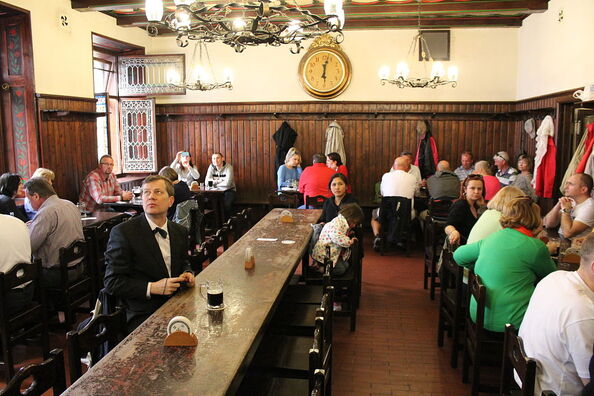
A view of one of the rooms at U Fleků, in 2014.
[Licensed under the Creative Commons Attribution-Share Alike 3.0 Unported licence, with
thanks to Wikimedia user Øyvind Holmstad for making his work available.]
[Licensed under the Creative Commons Attribution-Share Alike 3.0 Unported licence, with
thanks to Wikimedia user Øyvind Holmstad for making his work available.]
Tuesday 13.8.96
The day dawned bright and clear, a bit of a relief after the rain. After a sound breakfast we went to Holešovice to organise tickets and reservations for Dresden, and thence by two trams to Prague castle. It being high up, the tram is a Good Idea. An excellent day was had touristing, once we had realised the system (you go into the cathedral, half way round you realise you need a ticket to get into the interesting bits so you go back to the information desk and queue for ages to get a ticket, which is duly gripped in the appropriate place for each attraction). Lunch was taken outside one of the bars in the ‘cathedral close‘, which are a bit expensive even by UK standards and frighteningly so by Praha standards. Returning down the hill by tram we disembarked to walk across the Charles Bridge – very touristy and you can see why. This was followed up by a wander round the Old Town and a sample of Staropramen (dreary, no wonder they flog it in supermarkets in Telford in a f
[And there my notes for this trip end, about a third of the way down a sheet of paper and quite literally part of the way through a word. I have no idea what happened (nor what that f word was going to be, but it won't have been offensive) – clearly the page hasn’t been lost and I can only conjecture that I was writing them some time after the event, perhaps the next day, was interrupted and never managed to get round to finishing the story. As for Staropramen, in 1996 it belonged to Bass, then Interbrew, Inbev, CVC Capital Partners, and Molson Coors. A casualty of its times perhaps, but I've never learned to like it.]
Returning to our travels, or as much as I can remember 27 years later, it seems that we returned to the UK via Dresden and, presumably, our outward route. We certainly did some sightseeing in Dresden, notably including the Frauenkirche, destroyed in 1945. In 1996, only 3 years into its restoration, it was little more than a pile of materials retrieved from the débris and methodically organised on steel racking. We visited today’s beautifully restored Frauenkirche (reconsecrated 3.10.05) on 10.8.19, almost exactly 23 years after our first visit and found it breathtaking. ‘Before and after‘ photos are on the page relating to that second visit.
The day dawned bright and clear, a bit of a relief after the rain. After a sound breakfast we went to Holešovice to organise tickets and reservations for Dresden, and thence by two trams to Prague castle. It being high up, the tram is a Good Idea. An excellent day was had touristing, once we had realised the system (you go into the cathedral, half way round you realise you need a ticket to get into the interesting bits so you go back to the information desk and queue for ages to get a ticket, which is duly gripped in the appropriate place for each attraction). Lunch was taken outside one of the bars in the ‘cathedral close‘, which are a bit expensive even by UK standards and frighteningly so by Praha standards. Returning down the hill by tram we disembarked to walk across the Charles Bridge – very touristy and you can see why. This was followed up by a wander round the Old Town and a sample of Staropramen (dreary, no wonder they flog it in supermarkets in Telford in a f
[And there my notes for this trip end, about a third of the way down a sheet of paper and quite literally part of the way through a word. I have no idea what happened (nor what that f word was going to be, but it won't have been offensive) – clearly the page hasn’t been lost and I can only conjecture that I was writing them some time after the event, perhaps the next day, was interrupted and never managed to get round to finishing the story. As for Staropramen, in 1996 it belonged to Bass, then Interbrew, Inbev, CVC Capital Partners, and Molson Coors. A casualty of its times perhaps, but I've never learned to like it.]
Returning to our travels, or as much as I can remember 27 years later, it seems that we returned to the UK via Dresden and, presumably, our outward route. We certainly did some sightseeing in Dresden, notably including the Frauenkirche, destroyed in 1945. In 1996, only 3 years into its restoration, it was little more than a pile of materials retrieved from the débris and methodically organised on steel racking. We visited today’s beautifully restored Frauenkirche (reconsecrated 3.10.05) on 10.8.19, almost exactly 23 years after our first visit and found it breathtaking. ‘Before and after‘ photos are on the page relating to that second visit.
Once again my notes fail me, but my next outing seems to have been to Charleroi for a tram tour the following weekend - I've dug out some photographs and included them on the next page as they do show a bit of 'out with the old, in with the new' when compared with my visits to the same area in 1993 and 2022!
